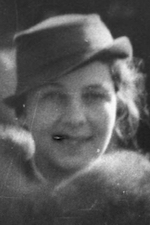Betty von Fürer-Haimendorf
Betty von Fürer-Haimendorf (1911 – 11 January 1987), born Elizabeth Barnardo, was a British ethnologist in India and Nepal. She was married to Austrian ethnologist Christoph von Fürer-Haimendorf.
Early life
[edit]Elizabeth Barnardo was born in Darbhanga, British India,[1] one of the five children of Col. Frederick "Barnie" Barnardo and Violet Barnardo, of Bexhill. Her father, also born in British India, was a physician with the Indian Medical Service,[2] nephew of Irish philanthropist Thomas John Barnardo, and dean of a medical school in Calcutta before 1921.[3] Her mother died by suicide in 1942. In girlhood, Betty Barnardo was close to Patience Gray, who became a noted food writer. The two young women traveled together in central Europe in 1937.[4]
Career
[edit]Barnardo, who had trained as a nurse,[5] worked closely with her husband on documenting the tribal cultures of northern India and Nepal.[6] "No Himalayan pass was too high for her, no field site too remote," recalled a colleague in a 1987 obituary.[7] She compiled the three-volume An anthropological bibliography of South Asia (1958).[8] With her husband, she co-wrote The Reddis of the Bison hills: A study in acculturation (1945),[9] The Raj Gonds of Adilabad: A peasant culture of the Deccan (1948), and The Gonds of Andhra Pradesh: Tradition and change in an Indian tribe (1979),[10] Her diaries became an important source of her husband's 1990 memoir, Life Among Indian Tribes: the Autobiography of an Anthropologist.[11]
Personal life
[edit]In 1938, Elizabeth Barnardo married Christoph von Fürer-Haimendorf. They had a son, Nicholas, born in 1946. She died in 1987, in Hyderabad.[7] The couple's papers are archived at the School of Oriental and African Studies (SOAS) at the University of London.[12]
References
[edit]- ^ Barnardo, Frederick (1963). An Active Life. Bodley Head. p. 178.
- ^ Frederick Adolphus Fleming Barnardo papers (1894-1962), The National Archives.
- ^ "Dr. Frederick Barnardo". The Times. 11 May 1962. p. 19. Retrieved October 24, 2020.
- ^ Federman, Adam (2017). Fasting and Feasting: The Life of Visionary Food Writer Patience Gray. Chelsea Green Publishing. pp. 10–11. ISBN 978-1-60358-752-5.
- ^ "Betty Haimendorf: Apa Tani Films". Mandala Collections, University of Virginia. Retrieved 2020-10-24.
- ^ Macfarlane, Alan (2010-10-14). "Early Ethnographic Film in Britain: A Reflection on the Work of Christoph von Fürer-Haimendorf". Visual Anthropology. 23 (5): 375–397. doi:10.1080/08949468.2010.508706. ISSN 0894-9468. S2CID 144069628.
- ^ a b "Obituary". Anthropology Today. 3 (1): 26. 1987. ISSN 0268-540X. JSTOR 3033273.
- ^ von Fürer-Haimendorf, Elizabeth (1958). An anthropological bibliography of South Asia, together with a directory of recent anthropological field work. (Book, 1958) [WorldCat.org]. OCLC 412100. Retrieved 2020-10-23 – via www.worldcat.org.
- ^ Fürer-Haimendorf, Christoph von; Fürer-Haimendorf, Elizabeth von; Mills, J. P (1945). The Reddis of the Bison hills: a study in acculturation. London: MacMillan. OCLC 17987535.
- ^ Fürer-Haimendorf, Christoph von, 1909-1995. (1979). The Gonds of Andhra Pradesh : tradition and change in an Indian tribe. Fürer-Haimendorf, Elizabeth von. London: George Allen & Unwin. ISBN 0-04-301090-3. OCLC 5842687.
{{cite book}}: CS1 maint: multiple names: authors list (link) CS1 maint: numeric names: authors list (link) - ^ MacFarlane, Alan; Turin, Mark (1996). "Christoph von Fürer-Haimendorf". Royal Anthropological Institute. Retrieved 2020-10-24.
- ^ "Papers of Professor Christoph von Fürer-Haimendorf". School of Oriental and African Studies (SOAS) Archives, University of London; via Archives Hub. Retrieved 2020-10-24.
External links
[edit]- "A Tribute to Christoph and Betty von Fürer-Haimendorf" (1996), a film by British anthropologist Mark Turin.
- "Betty von Furer-Haimendorf and Apatanis" (1944), a photograph of von Fürer-Haimendorf by her husband, one of several photos of her, taken 1939 to 1974, in the collection of SOAS University of London.

